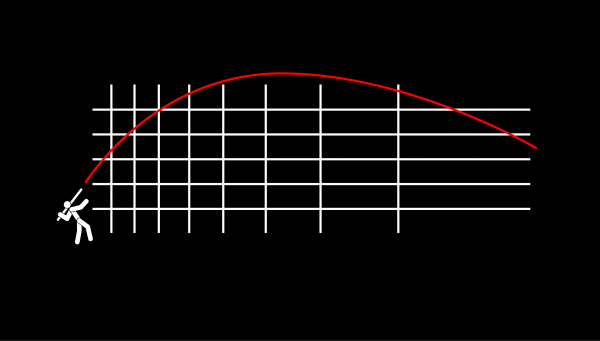Most events where Pikip systems are used take place outdoors, sometimes near residential areas or in city centers. In these situations, sound systems can potentially cause noise disturbances for nearby residents.
This issue has become more critical since 2018, following the implementation of the French "sound decree" of August 7, 2017, which sets limits on sound levels during and around events.
To mitigate these disturbances, one solution exists: directional control. The idea is to focus sound energy on the audience, rather than letting it spill over into neighboring areas. While high frequencies are naturally more directional (learn more about acoustic radiation laws here >>), low frequencies are much more omnidirectional, which requires clever solutions. By combining several omnidirectional speakers, it's possible to shape the overall directivity of the system (just like with microphones!).
Note: Indoors, directional control also helps reduce reverberation in acoustically poor venues by targeting sound waves only toward the useful listening area and limiting reflections from back walls. It also helps reduce low-frequency build-up on stage, improving comfort for musicians by avoiding a muddy bass mix.
Several methods for combining omnidirectional speakers have been developed. The most well-known are the gradient array (inline or inverted cardioid) and the end-fire array (pseudo-cardioid). Each method has its pros and cons, and use cases depend on stage size and speaker count, but all aim to reduce unwanted dispersion and focus acoustic energy where it’s needed. This article focuses mainly on the inverted gradient array, with brief descriptions of the inline gradient and end-fire arrays.
Cardioid with Inverted Gradient Setup
There are two types of gradient setups: inline gradient (with two elements) and inverted gradient (with three elements). The inverted gradient is the most widely used, and that’s what we’ll describe here.
In summary:
— Easy to implement
— Good directional control
— Clean impulse response
— Doesn’t require many speakers
This system was first described by Harry Olson in 1973 in his article "Gradient Loudspeakers” (available here >>). It is widely used at concerts due to its simplicity and effectiveness.
In an inverted gradient cardioid, the concept is this: two front-facing speakers direct sound toward the audience, while a third speaker is turned backwards. This rear-facing speaker emits a phase-inverted and delayed wave to cancel out sound at the back (via destructive interference).
How it Works
The front-facing speakers operate normally—no delay, and normal polarity (i.e., the signal is unaltered).
The rear-facing speaker has its polarity inverted, and a delay is applied using the formula:
Delay = d/c
d is the distance between the front and rear speaker cones, taking into account the physical layout and system dimensions.
c is the speed of sound (343 m/s at 20°C), taking into account the size of the sound system that the wave must bypass.
Note: These “omnidirectional” speakers still exhibit about -6 dB of rear attenuation, which is why one speaker needs to be flipped around.
Acoustic Effects
- The inverted phase and delay on the rear speaker create cancellation with the waves from the front speakers (which themselves have some rear attenuation).
- At the front, the contribution from the rear speaker is weaker (about -12 dB compared to the front ones) and slightly delayed, so the total sound is almost as if only the two front speakers were active.
To visualize this, here's an explanatory diagram:

At the front, combining the two forward-facing speakers with the delayed, phase-inverted rear speaker introduces a small phase shift. This leads to a +0.5 dB increase, compared to a +3.5 dB gain if all three were in phase and facing forward. The impulse response is slightly elongated, which may even be beneficial in reverberant spaces, as it avoids overlapping with delayed rear wall reflections.
In the case of PikiP, our subwoofers are pseudo-omnidirectional to facilitate the cardioid pattern. Here's what the results look like for a stack of four VTL118s in inverted gradient configuration:


Other Configurations:
Inline Gradient
This setup uses two speakers spaced by distance d. The rear speaker receives a phase-inverted signal with a delay matching the distance d. This causes cancellation of backward sound. At the front, both speakers add together, but with a significant phase difference, degrading the impulse response.
End-fire
The end-fire arrangement resembles the inline gradient arrangement due to the alignment of the speakers, but it is completely different in the way it cancels the waves at the rear. It involves a minimum of four speakers, spaced from each other by a distance d. Delays are applied in such a way that all the waves are in phase at the front. The rear waves have random phases (due to the spacing and delays), which creates broadband cancellation, provided that at least four speakers are used; otherwise, the cancellation will only occur at certain frequencies.The advantages of this method are energy efficiency and a good impulse response, since the waves sum perfectly at the front. However, it requires a lot of space between the audience and the stage, and the setup is more complex than with an inverted gradient (requires measurement, etc.). In addition, the rear cancellation improves as one moves away from the speakers — which is good for the neighbors, but less so for the musicians on stage.
Conclusion:
Controlling low-frequency directivity is sometimes essential to prevent noise pollution and ensure stage comfort. Several methods exist for achieving this.
The inverted gradient configuration is a practical and efficient way to create a cardioid pattern. It’s simple, requires few speakers, and takes up little space. Its main downside is reduced energy efficiency: to achieve -12 dB at the rear, you typically lose about 3 dB at the front compared to a three-speaker system with all drivers in phase.
An alternative is the end-fire configuration, which avoids this drawback. It provides good directivity control while maintaining efficiency and impulse response. However, it demands more space and at least four subwoofers, and tuning must be done on-site.
PikiP provides presets for the inverted gradient setup, as it’s the most versatile and easiest to implement. That said, before using any cardioid configuration, you should weigh the trade-offs between noise reduction, sound pressure levels, energy efficiency (more on that here >>), and battery life. If the conditions allow, end-fire is absolutely possible—and recommended—with PikiP speakers!










